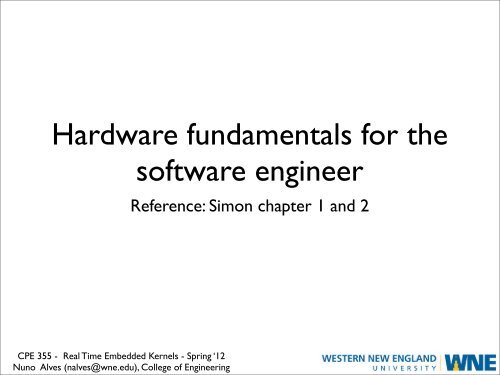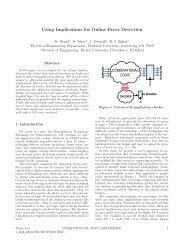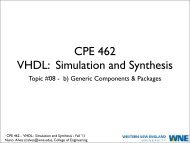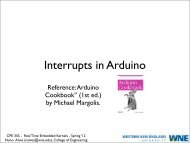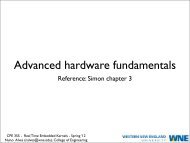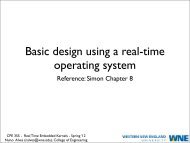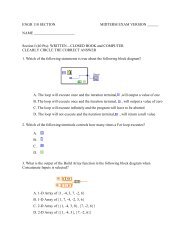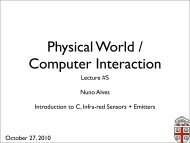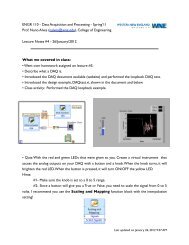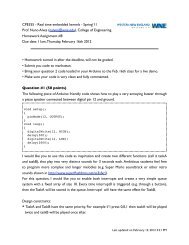Hardware fundamentals for the software engineer - Nuno Alves
Hardware fundamentals for the software engineer - Nuno Alves
Hardware fundamentals for the software engineer - Nuno Alves
Create successful ePaper yourself
Turn your PDF publications into a flip-book with our unique Google optimized e-Paper software.
<strong>Hardware</strong> <strong>fundamentals</strong> <strong>for</strong> <strong>the</strong><br />
<strong>software</strong> <strong>engineer</strong><br />
Reference: Simon chapter 1 and 2<br />
CPE 355 - Real Time Embedded Kernels - Spring ‘12<br />
<strong>Nuno</strong> <strong>Alves</strong> (nalves@wne.edu), College of Engineering
Embedded system<br />
• An embedded system is any computer system<br />
inside a product o<strong>the</strong>r than a computer<br />
• Embedded systems have a processor and a<br />
memory. Some have a serial port or a network<br />
connection. The usually not have keyboards,<br />
screens or disk drives.<br />
CPE 355 - Real Time Embedded Kernels - Spring ‘12<br />
<strong>Nuno</strong> <strong>Alves</strong> (nalves@wne.edu), College of Engineering
Difficulties when writing<br />
embedded <strong>software</strong><br />
CPE 355 - Real Time Embedded Kernels - Spring ‘12<br />
<strong>Nuno</strong> <strong>Alves</strong> (nalves@wne.edu), College of Engineering
Some difficulties<br />
• Throughput: Your system may need to handle a lot of data in a<br />
short period of time.<br />
• Response: You system may need to react to events quickly.<br />
• Testability: Setting up equipment to test your embedded<br />
system may be hard.<br />
• Debugability: Without a screen of a keyboard, finding out<br />
what is wrong with your application (besides <strong>the</strong> fact that its not<br />
working) can be hard.<br />
CPE 355 - Real Time Embedded Kernels - Spring ‘12<br />
<strong>Nuno</strong> <strong>Alves</strong> (nalves@wne.edu), College of Engineering
More difficulties<br />
• Reliability: Embedded systems must be able to handle any<br />
situation without human intervention.<br />
• Memory space: Memory is limited on embedded systems, and<br />
you must make <strong>the</strong> <strong>software</strong> and <strong>the</strong> data fit in whatever.<br />
memory exists<br />
• Program installation: You need special tools to get your<br />
<strong>software</strong> in embedded systems.<br />
• Power consumption: Portable systems must run on battery<br />
power, and <strong>the</strong> <strong>software</strong> in <strong>the</strong>se systems must conserve power.<br />
CPE 355 - Real Time Embedded Kernels - Spring ‘12<br />
<strong>Nuno</strong> <strong>Alves</strong> (nalves@wne.edu), College of Engineering
Even more difficulties<br />
• Processor hogs: Computing that requires large amounts of<br />
CPU time may complicate <strong>the</strong> response problem.<br />
• Cost: Reducing <strong>the</strong> cost of <strong>the</strong> hardware is a concern <strong>for</strong> many<br />
embedded systems; often time <strong>software</strong> functions on a barely<br />
adequate system <strong>for</strong> <strong>the</strong> job.<br />
CPE 355 - Real Time Embedded Kernels - Spring ‘12<br />
<strong>Nuno</strong> <strong>Alves</strong> (nalves@wne.edu), College of Engineering
<strong>Hardware</strong> <strong>fundamentals</strong>:<br />
terminology<br />
CPE 355 - Real Time Embedded Kernels - Spring ‘12<br />
<strong>Nuno</strong> <strong>Alves</strong> (nalves@wne.edu), College of Engineering
CPE 355 - Real Time Embedded Kernels - Spring ‘12<br />
<strong>Nuno</strong> <strong>Alves</strong> (nalves@wne.edu), College of Engineering
Signal assertion<br />
• Every circuit contains many signals whose purpose is to<br />
indicate various conditions. For example “reset <strong>the</strong><br />
microprocessor”, or “get this data from this memory chip”.<br />
• These signals are said to be asserted, when <strong>the</strong>y are<br />
signaling whatever <strong>the</strong>y want to signal.<br />
• For example when <strong>the</strong> microprocessor needs data from<br />
memory, <strong>the</strong> <strong>engineer</strong> must assert <strong>the</strong> “get this data from<br />
this memory chip” signal.<br />
• Some signals may be asserted when HIGH o<strong>the</strong>rs when<br />
LOW.<br />
CPE 355 - Real Time Embedded Kernels - Spring ‘12<br />
<strong>Nuno</strong> <strong>Alves</strong> (nalves@wne.edu), College of Engineering
Naming conventions<br />
• Most of <strong>the</strong> signals in <strong>the</strong> design have different labels.<br />
• Data signals are usually named D0, D1, D2,...<br />
• Address signals are usually named A0, A1, A2,...<br />
• The signal that indicates “read memory now” is<br />
usually MEMREAD.<br />
ROM<br />
• If <strong>the</strong>re is a slash (/) or an asterisk (*), usually means<br />
that a LOW signal must be asserted <strong>for</strong> <strong>the</strong> desired<br />
outcome to occur.<br />
DFlip Flop<br />
CPE 355 - Real Time Embedded Kernels - Spring ‘12<br />
<strong>Nuno</strong> <strong>Alves</strong> (nalves@wne.edu), College of Engineering
CPE 355 - Real Time Embedded Kernels - Spring ‘12<br />
<strong>Nuno</strong> <strong>Alves</strong> (nalves@wne.edu), College of Engineering<br />
Floating outputs
Floating output is has an high<br />
impedance state<br />
• If no part of <strong>the</strong> circuit is driving a signal, <strong>the</strong>n <strong>the</strong> signal is said to<br />
be floating.<br />
• Floating output = high impedance = Z<br />
• Its voltage is indeterminate and may change as time passes.<br />
CPE 355 - Real Time Embedded Kernels - Spring ‘12<br />
<strong>Nuno</strong> <strong>Alves</strong> (nalves@wne.edu), College of Engineering
What is <strong>the</strong> purpose of adding buffers<br />
• This AND gate has a fanout of 4<br />
• If each of <strong>the</strong> four devices gets equal current, <strong>the</strong>n each device gets 1/4 of <strong>the</strong><br />
initial current<br />
• By adding a buffer, I am boosting current to each device<br />
• This can be done because a buffer has a power connection<br />
Important: Why should I care about ensuring each gate gets a decent amount of<br />
current? You can’t really accurately measure voltage levels if <strong>the</strong>re is no current!<br />
CPE 355 - Real Time Embedded Kernels - Spring ‘12<br />
<strong>Nuno</strong> <strong>Alves</strong> (nalves@wne.edu), College of Engineering
Example of a loading problem<br />
•The OVERLOADED line does<br />
not have enough current to load<br />
all <strong>the</strong> chips.<br />
•With a driver, we should have<br />
enough current to load all <strong>the</strong><br />
elements.<br />
•As <strong>software</strong> <strong>engineer</strong>s we don’t<br />
have to deal with <strong>the</strong>se things,<br />
but <strong>the</strong>y normally show up in<br />
designs and we need to know<br />
what <strong>the</strong>y are doing.<br />
CPE 355 - Real Time Embedded Kernels - Spring ‘12<br />
<strong>Nuno</strong> <strong>Alves</strong> (nalves@wne.edu), College of Engineering
What is High Impedance (Z)?<br />
•We can define a wire as a piece of conductive material<br />
that allows electron flow<br />
• A wire allows a 1-bit signal to be sent on it<br />
• At most one device can write to a wire<br />
• A device can write ei<strong>the</strong>r a ‘0’ or ‘1’ on <strong>the</strong> wire<br />
• Devices can read from <strong>the</strong> wire<br />
cpu<br />
memory<br />
hard-disk<br />
CPE 355 - Real Time Embedded Kernels - Spring ‘12<br />
<strong>Nuno</strong> <strong>Alves</strong> (nalves@wne.edu), College of Engineering
Wire may connect multiple devices<br />
• When a device writes a ‘1’ or ‘0’, in reality, it is asserting a<br />
voltage, such as 0 volts <strong>for</strong> ‘0’ and 5 volts <strong>for</strong> ‘1’<br />
• If two devices attempt to write a ‘0’ and ‘1’, <strong>the</strong>n <strong>the</strong> wire is<br />
assumed to have a garbage value<br />
• A device attempting to read from <strong>the</strong> wire, in such a situation,<br />
may read ‘0's’ sometimes and read ‘1's’ at o<strong>the</strong>r times<br />
• We want to avoid two devices writing at <strong>the</strong> same time<br />
• More than one device can read a value from a wire<br />
CPE 355 - Real Time Embedded Kernels - Spring ‘12<br />
<strong>Nuno</strong> <strong>Alves</strong> (nalves@wne.edu), College of Engineering
High impedance state<br />
• If no devices write to <strong>the</strong> wire, <strong>the</strong>n <strong>the</strong> wire has value Z,<br />
which stands <strong>for</strong> high impedance<br />
• High impedance means that it is nei<strong>the</strong>r 0 nor 1<br />
• If no device is writing to a wire, <strong>the</strong>n reading from a wire gets<br />
an unknown value (ei<strong>the</strong>r 0 or 1, but nothing predictable)<br />
• A wire has no memory. That is, if you write a logic-1 to <strong>the</strong><br />
wire, <strong>the</strong> wire does not store <strong>the</strong> value. The device must<br />
continuously assert a logic-1<br />
CPE 355 - Real Time Embedded Kernels - Spring ‘12<br />
<strong>Nuno</strong> <strong>Alves</strong> (nalves@wne.edu), College of Engineering
What is a tri-state buffer?<br />
in<br />
out<br />
This is how a tri-state buffer looks like....<br />
If B is OFF, <strong>the</strong>n output C is floating.<br />
CMOS implementation of a tri-state buffer<br />
CPE 355 - Real Time Embedded Kernels - Spring ‘12<br />
<strong>Nuno</strong> <strong>Alves</strong> (nalves@wne.edu), College of Engineering
Quick review on transmission gates<br />
Transistors can be used as switches<br />
Transmission gates pass strong 1’s and 0’s<br />
CPE 355 - Real Time Embedded Kernels - Spring ‘12<br />
<strong>Nuno</strong> <strong>Alves</strong> (nalves@wne.edu), College of Engineering
Wire truth-table<br />
Device #1 Device #2 Output<br />
Write 0 Write 0 0<br />
Write 0 Write 1 Garbage<br />
Write 1 Write 0 Garbage<br />
Write 1 Write 1 1<br />
Write nothing<br />
(Z)<br />
Write 0 0<br />
Garbage as in... sometimes we read<br />
a ‘1’ o<strong>the</strong>r times we read a ‘0’.<br />
Write nothing<br />
(Z)<br />
Write 1 1<br />
Write nothing<br />
(Z)<br />
Write nothing<br />
(Z)<br />
Nothing (Z)<br />
CPE 355 - Real Time Embedded Kernels - Spring ‘12<br />
<strong>Nuno</strong> <strong>Alves</strong> (nalves@wne.edu), College of Engineering
Tri-state buffer is a control valve<br />
• When <strong>the</strong> control input is not active, <strong>the</strong> output is "Z"<br />
• The "valve" is open, and no electrical current flows<br />
through<br />
• Thus, even if x is 0 or 1, that value does not flow through<br />
c in out<br />
0 0 Z<br />
in<br />
out<br />
0 1 Z<br />
1 0 0<br />
1 1 1<br />
CPE 355 - Real Time Embedded Kernels - Spring ‘12<br />
<strong>Nuno</strong> <strong>Alves</strong> (nalves@wne.edu), College of Engineering
Tri-state buffer usage example<br />
• If SELECT A is asserted, SELECT<br />
B and SELECT C not, <strong>the</strong>n<br />
INPUT A will drive <strong>the</strong> OUTPUT<br />
signal high or low.<br />
• A microprocessor, a memory<br />
chip and some I/O devices must<br />
send bytes to one ano<strong>the</strong>r.<br />
Having a tri-state buffer allows<br />
us to have a single data bus that<br />
just send signals.<br />
CPE 355 - Real Time Embedded Kernels - Spring ‘12<br />
<strong>Nuno</strong> <strong>Alves</strong> (nalves@wne.edu), College of Engineering
Ano<strong>the</strong>r example, now with 32 bit tristate<br />
buffers<br />
• A common way <strong>for</strong> many devices<br />
to communicate with one ano<strong>the</strong>r<br />
is on a bus<br />
• That a bus should only have one<br />
device writing to it, although it can<br />
have many devices reading from it<br />
• Since many devices always produce<br />
output (such as registers) and<br />
<strong>the</strong>se devices are hooked to a bus,<br />
we need a way to control what<br />
gets on <strong>the</strong> bus, and what doesn't.<br />
CPE 355 - Real Time Embedded Kernels - Spring ‘12<br />
<strong>Nuno</strong> <strong>Alves</strong> (nalves@wne.edu), College of Engineering
Tri-state buffers vs MUX<br />
• Who cares? Why don’t I replace<br />
<strong>the</strong>se three state buffers with a<br />
single MUX?<br />
• With a MUX we're guaranteed only<br />
one device makes it to <strong>the</strong> bus.<br />
• However, <strong>the</strong> MUX ensures that at<br />
least one signal must be on <strong>the</strong><br />
BUS. What if we don’t want any<br />
devices to make it to <strong>the</strong> bus?<br />
• Yeah... sure... we can always add an<br />
enable input to a MUX.<br />
CPE 355 - Real Time Embedded Kernels - Spring ‘12<br />
<strong>Nuno</strong> <strong>Alves</strong> (nalves@wne.edu), College of Engineering
Bus fight<br />
•If two parts drive <strong>the</strong> same signal with <strong>the</strong> same value <strong>the</strong>re is<br />
no problem.<br />
•If two parts drive a different signal on <strong>the</strong> same bus, <strong>the</strong>n we<br />
have a big problem!<br />
•The parts get very hot and usually <strong>the</strong>y get damaged (this is a<br />
called a bus fight).<br />
•Bus fights that occur <strong>for</strong> very short periods of time<br />
(nanoseconds) will not be enough to destroy <strong>the</strong> pieces, but<br />
<strong>the</strong> system will operate unreliably.<br />
•A bus fight is as indication of poor hardware design.<br />
CPE 355 - Real Time Embedded Kernels - Spring ‘12<br />
<strong>Nuno</strong> <strong>Alves</strong> (nalves@wne.edu), College of Engineering
Power and Decoupling<br />
CPE 355 - Real Time Embedded Kernels - Spring ‘12<br />
<strong>Nuno</strong> <strong>Alves</strong> (nalves@wne.edu), College of Engineering
Signal activity<br />
• Each circuit in a chip has a power pin and also a ground pin.<br />
• However this is not often visually represented on circuit schematics.<br />
• Problem: Sometimes some of <strong>the</strong>se chips use more power than<br />
o<strong>the</strong>rs. If a chip must change many of its inputs from LOW to HIGH or<br />
HIGH to LOW at <strong>the</strong> same time, <strong>the</strong>n this requires a lot of power.<br />
CPE 355 - Real Time Embedded Kernels - Spring ‘12<br />
<strong>Nuno</strong> <strong>Alves</strong> (nalves@wne.edu), College of Engineering
Decoupling capacitors<br />
• To prevent localized power brownout <strong>for</strong> a few<br />
micro-seconds we need to address this issue.<br />
• Most chips stop working temporarily if <strong>the</strong> voltage<br />
drops below 10%.<br />
• To deal with <strong>the</strong>se <strong>engineer</strong>s must add capacitors to<br />
<strong>the</strong> circuit, with one end connected to <strong>the</strong> signal<br />
providing power, and <strong>the</strong> o<strong>the</strong>r end connected to<br />
ground.<br />
• A capacitor stores a minuscule amount of energy, like<br />
a very small rechargeable battery.<br />
CPE 355 - Real Time Embedded Kernels - Spring ‘12<br />
<strong>Nuno</strong> <strong>Alves</strong> (nalves@wne.edu), College of Engineering
Open collector and tri-state<br />
outputs<br />
CPE 355 - Real Time Embedded Kernels - Spring ‘12<br />
<strong>Nuno</strong> <strong>Alves</strong> (nalves@wne.edu), College of Engineering
Open collector<br />
• One special class of outputs allows to<br />
attach <strong>the</strong> outputs of several devices<br />
toge<strong>the</strong>r to drive a single signal.<br />
• Unlike <strong>the</strong> usual signals that drive signals<br />
HIGH or LOW, <strong>the</strong> open collector can drive<br />
<strong>the</strong> outputs HIGH, LOW or leave <strong>the</strong>m<br />
floating.<br />
• With open collectors <strong>the</strong>re is no such thing<br />
as a bus fight. If one signal is driven low, all<br />
are driven low.<br />
CPE 355 - Real Time Embedded Kernels - Spring ‘12<br />
<strong>Nuno</strong> <strong>Alves</strong> (nalves@wne.edu), College of Engineering
Open collector example<br />
• Example: your microprocessor only has one<br />
input <strong>for</strong> <strong>the</strong> interrupt, but we have two devices<br />
that need to signal interrupts.<br />
• The interrupt (INT/) input is triggered with a<br />
LOW signal. Hence <strong>the</strong> slash (/) after <strong>the</strong> INT.<br />
• If one of <strong>the</strong> chips wants to trigger <strong>the</strong> INT/,<br />
<strong>the</strong>n it drives <strong>the</strong> interrupt line to LOW.<br />
• If no chips want to trigger an interrupt, <strong>the</strong>n <strong>the</strong><br />
pullup resistor will ensure INT/ is HIGH.<br />
CPE 355 - Real Time Embedded Kernels - Spring ‘12<br />
<strong>Nuno</strong> <strong>Alves</strong> (nalves@wne.edu), College of Engineering
Warnings<br />
• You cannot omit <strong>the</strong> pullup resistor and connect INT/ directly to VCC!<br />
• If you did this, you’d have a bus fight, as soon as one of <strong>the</strong> chips tried to<br />
drive INT/ LOW, since VCC would try to keep INT/ HIGH.<br />
CPE 355 - Real Time Embedded Kernels - Spring ‘12<br />
<strong>Nuno</strong> <strong>Alves</strong> (nalves@wne.edu), College of Engineering
CPE 355 - Real Time Embedded Kernels - Spring ‘12<br />
<strong>Nuno</strong> <strong>Alves</strong> (nalves@wne.edu), College of Engineering<br />
Memory
Read only memory<br />
• Non-volatile, means its contents do not disappear<br />
once power goes out.<br />
• The microprocessor can read contents from ROM<br />
as fast at it can execute <strong>the</strong>m<br />
• The micro processor cannot write new data into<br />
<strong>the</strong> ROM (data is unchangeable)<br />
• When <strong>the</strong> power is turned ON <strong>the</strong> microprocessor<br />
will start fetching <strong>the</strong> program from <strong>the</strong><br />
rom.<br />
ROM<br />
CPE 355 - Real Time Embedded Kernels - Spring ‘12<br />
<strong>Nuno</strong> <strong>Alves</strong> (nalves@wne.edu), College of Engineering
Typical ROM signals<br />
• A0, A1, A2,... address signals, which indicates <strong>the</strong><br />
address we want to read from ROM<br />
• D0, D1, ... are <strong>the</strong> data signals driven by <strong>the</strong><br />
ROM block. They are normally 16.<br />
• CE/ is <strong>the</strong> chip select signal. The ROM will<br />
ignore anything, unless CE/ is asserted (a “/”<br />
indicates its a 0)<br />
• RE/ is <strong>the</strong> read enable signal, which tells that<br />
<strong>the</strong> ROM should output <strong>the</strong> data elements when<br />
signal is asserted.<br />
ROM<br />
CPE 355 - Real Time Embedded Kernels - Spring ‘12<br />
<strong>Nuno</strong> <strong>Alves</strong> (nalves@wne.edu), College of Engineering
Timing example<br />
• The boxed part of <strong>the</strong> signal indicated<br />
that multiple values are changing.<br />
1.Microprocessor drives <strong>the</strong> ROM<br />
address lines with location it wants to<br />
fetch from ROM<br />
2. Asserts CE/ signal<br />
3. A little while later it will assert <strong>the</strong><br />
RE/<br />
4. After some delay, <strong>the</strong> data lines will<br />
contain <strong>the</strong> appropriate data.<br />
CPE 355 - Real Time Embedded Kernels - Spring ‘12<br />
<strong>Nuno</strong> <strong>Alves</strong> (nalves@wne.edu), College of Engineering<br />
ROM
Random Access Memory<br />
• Microprocessor can read data from RAM faster than ROM.<br />
• Microprocessor can write data into RAM, but that data<br />
disappears after power is turned off.<br />
• RAM is not a good place to store <strong>the</strong> program, but raw data.<br />
• Two types of RAM: SRAM and DRAM.<br />
DRAM<br />
SRAM<br />
DRAM<br />
CPE 355 - Real Time Embedded Kernels - Spring ‘12<br />
<strong>Nuno</strong> <strong>Alves</strong> (nalves@wne.edu), College of Engineering


